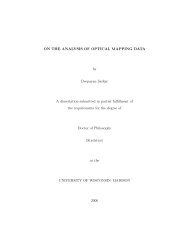Struggles with Survey Weighting and Regression Modeling paper
Struggles with Survey Weighting and Regression Modeling paper
Struggles with Survey Weighting and Regression Modeling paper
You also want an ePaper? Increase the reach of your titles
YUMPU automatically turns print PDFs into web optimized ePapers that Google loves.
158 A. GELMAN<br />
difference in log earnings between whites <strong>and</strong> nonwhites;<br />
this is also a regression, but because the predictor<br />
z is binary, it is defined unambiguously as a difference.<br />
Again, we suppose for simplicity that the survey<br />
is adjusted only for sex. The estimated regression fit,<br />
including the interaction, is<br />
y = log(earnings)<br />
= 9.5 − 0.02 · white + 0.20 · male<br />
+ 0.41 · white · male + error.<br />
The population difference in log earnings is then<br />
E(y|white = 1) − E(y|white = 0)<br />
=−0.02 + 0.20 · (E(male|white = 1)<br />
− E(male|white = 0) )<br />
+ 0.41 · E(male|white = 1),<br />
<strong>and</strong> the factors E(male|white = 0) <strong>and</strong> E(male|<br />
white = 1) can be estimated from the data. More generally,<br />
this example illustrates that, once we fit an interaction<br />
model in a survey adjustment context, we cannot<br />
simply consider a single regression coefficient (in this<br />
case, for white) but rather must also use the interacted<br />
terms in averaging over poststratification cells.<br />
Our focus in this article is on the relation between<br />
the model for the survey response <strong>and</strong> the corresponding<br />
weighted-average estimate. The ultimate goal is to<br />
have a model-based procedure for constructing survey<br />
weights, or conversely to set up a framework for regression<br />
modeling that gives efficient <strong>and</strong> approximately<br />
unbiased estimates in a survey-adjustment context.<br />
2. THE CHALLENGE<br />
2.1 Estimating Simple Averages <strong>and</strong> Trends<br />
We now return to the example of Table 1. The goal is<br />
to estimate Y 2001 − Y 1999 , the change in population average<br />
response between two waves of the Social Indicators<br />
<strong>Survey</strong>. This can be formulated as the coefficient<br />
β 1 in a regression of y on time: y = β 0 + β 1 z + error,<br />
where the data from the two surveys are combined, <strong>and</strong><br />
z = 0 <strong>and</strong> 1 for respondents of the 1999 <strong>and</strong> 2001 surveys,<br />
respectively.<br />
A more general model is y = β 0 +β 1 z+β 2 X+error,<br />
where β 2 is a vector of coefficients for the variables X<br />
used in the weighting. Now the quantity of interest is<br />
β 1 + β 2 (X 2001 − X 1999 ), to account for demographic<br />
changes between the two years. For New York City<br />
between 1999 <strong>and</strong> 2001, these demographic changes<br />
were minor, <strong>and</strong> so it is reasonable to simply consider<br />
β 1 to be the quantity of interest.<br />
This brings us to the puzzle of Table 1. For each<br />
of three binary outcomes y, we compute the weighted<br />
mean for each year, ȳw 1999 <strong>and</strong> ȳw<br />
2001 , <strong>and</strong> two estimates<br />
of the change:<br />
• Our first estimate is the simple<br />
√<br />
difference, ȳw<br />
2001 −<br />
ȳw<br />
1999,<br />
<strong>with</strong> st<strong>and</strong>ard error var(ȳw<br />
2001)<br />
+ var(ȳ1999 w ),<br />
where the sampling variances are computed using<br />
the design of the weights (as in the rightmost column<br />
in Table 3).<br />
• Our other estimate is obtained by linear regression.<br />
We combine the data from the two surveys into a<br />
single vector, y = (y 1999 ,y 2001 ), <strong>and</strong> create an associated<br />
indicator vector z that equals 0 for the data<br />
from 1999 <strong>and</strong> 1 for the data from 2001. We fit a<br />
linear regression of y on z, also controlling for the<br />
variables X used in the weighting. (These X variables<br />
are number of adults in the household, number<br />
of children in the family, number of telephone lines,<br />
marital status, <strong>and</strong> sex, age, ethnicity <strong>and</strong> education,<br />
<strong>and</strong> ethnicity × education for the head of household.)<br />
To estimate the change from 1999 to 2001,<br />
we use the coefficient of z, <strong>with</strong> st<strong>and</strong>ard error automatically<br />
coming from the (unweighted) regression.<br />
As indicated in the third <strong>and</strong> fourth columns of Table<br />
1, the regression coefficient <strong>and</strong> the change in<br />
weighted averages tend to have the same sign, but the<br />
two estimates sometimes differ quite a bit in magnitude.<br />
(Similar results are obtained if we work on the<br />
logit scale, as can be seen from the final two columns<br />
of the table.)<br />
What should we believe? For this particular example,<br />
the direct analysis of weighted averages seems<br />
more believable to us, since we specifically created<br />
the weighting procedure for the goal of estimating<br />
these citywide averages. More generally, however, using<br />
weighted averages is awkward <strong>and</strong> we would prefer<br />
to use the more general techniques of regression <strong>and</strong><br />
poststratification.<br />
Where do we go from here? We would like an approach<br />
to statistical analysis of survey data that gives<br />
the right answers for simple averages <strong>and</strong> comparisons,<br />
<strong>and</strong> can be smoothly generalized to more complicated<br />
estim<strong>and</strong>s.<br />
2.2 Deep Poststratification<br />
One of the difficulties of survey weighting is that<br />
the number of poststratification cells can quickly become<br />
large, even exceeding the number of respondents.
















